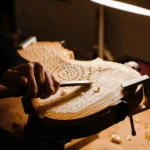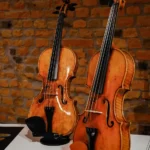The Secrets Of An Expert: How Does A Violin Sound Great?
Back to BlogThe violin makers, the experts, build instruments so beautifully that is hard to imagine how they can make such a masterpiece! Well, for a violin to sound great, there is no mystery, but hours and hours of labor and some more spent in studies. A luthier has way more work than you can think of and the answer to the beautiful sound of a violin is in the whole process of the making.
Beyond just making good violins, to create a truly great instrument, it’s important to not only be beautiful, but it must perform its assigned task well.
The construction of a violin sound starts at the wood.
The bottom and top plates of instruments must be well-dried before being cut into sound boxes, as the thickness of the plates makes a difference in how sounds are produced. In particular, this step is important because it allows for the wood to dry for a decade before being used. A top pick is a maple and spruce because of their properties, but an instrument can be made of other kinds of wood. It depends on the luthier’s line of work.
For an instrument to sound good, it must have a well-tuned top and bottom plate. The wood for the plates should be very dry and have been air-dried for at least ten years. Most makers use wood from “Val di Fiemme / Italia,” the same source Stradivarius and Guarneri used in the 1700s. The vibrations of this wood are lighter and more resonant, making it ideal for an instrument. Beyond that, it is a light wood, and the thinness helps achieve an acoustic balance in the finished instrument.
During the process of making, some luthiers take notes, searching for a good amplitude of the sound. The most important of all is to train the ear and understand the various nuances that this intimate moment during the instrument’s making provides. In the past, the master makers had nothing else to help them in this process but their hearing to achieve an excellent result. Nowadays, we can count on technology for precision.
Other processes and accessories will also help to determine the instrument sound.
The bass bar runs beneath the bridge, and the length and height have been adjusted due to the increase of pressure exerted in the top plate. Not only does it support the top plate, but it also distributes the weight of the strings. The pick of the wood here is crucial and preferable, the same used at the top. For a sound to be prolonged, split wood should be used, and the broken ends must not be crushed.
Special attention to the gluing part will give a better result and avoid something in the future. Delicately beautiful F-shaped holes grace the front plate. The f-holes or soundholes add more modes of vibration at high frequencies. More importantly, they increase the volume of low-frequency sound output. The instrument’s frequency is determined by the size of the f-holes and their volume. It’s this particular frequency that violin makers can control most easily.
Although it’s not the main character here, the varnish will influence your instrument’s sound. Its primary purpose is to protect your violin. However, the composition and the way the maker applies it will significantly impact the final result.
Care and maintenance are very important to your violin sound
Special care is more than important. The weather can change your instrument sound; the fluctuations and changes in the humidity levels are dangerous. Be aware of them and always keep an eye on them. Cleaning, small changes, and adjustments can make your instrument sound like a completely new one!









